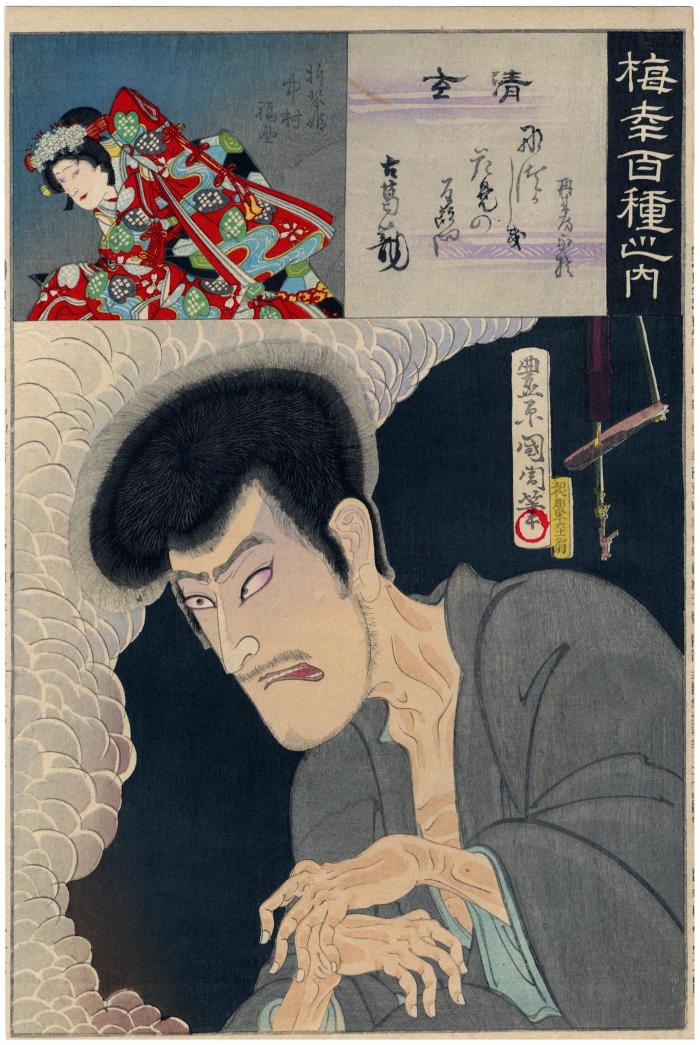Toyohara Kunichika (豊原国周) (artist 1835 – 1900)
Onoe Kikugorō V as the ghost Seigen (清玄) and Nakamura Fukusuke IV (中村福助) as Sakura-hime (折琴姫) from the series One Hundred Roles of Baikō (Baikō hyakushu no uchi - 梅幸百種之内)
1893
Signed: Toyohara Kunichika hitsu
豊原国周筆
Artist's seal: toshidama
Carver: Shodai Hori Ei rokujūichi okina
Waseda University
Tokyo Metropolitan Library
Hankyu Culture Foundation
Keio University
Lyon Collection - another print from this series: Yamamoto Kansuke There are many variations on the story of Seigen. In Beauty and Violence: Japanese Prints by Yoshitosh 1839-1892 the authors state on page 90:
"[Priests were often expected to take a vow of chastity. However,] ...Seigen, who fell in love with Sakurahime [broke that vow]. But this story also exists in a number of versions. In one version he was repulsed by Sakurahime, became insane and was expelled from the temple, Kiyomizu, in Kyoto, after which he starved himself to death and haunted Sakurahime until she died of fright. This version was told in Santō Kyōden's (1761-1816) novel Sakurahimezenden akebonozōshi. The kabuki play Sakurahime azuma bunshō (1817) by Tsuruya Nanboku (1755-1829) recounts a more involved tale. In this play Sakurahime is the reincarnation of a young boy, Shiragiku. Seventeen years earlier Seigen, then called Jikyū, had been in love with him and they jumped off a cliff in an effort to commit suicide. Fortunately (or unfortunately) Seigen survived and is now once more confronted by Shiragiku. In the course of this play Seigen dies as a result of Sakurahime's actions, in which he has no share. He accepts her intrigues, because after seventeen years he still feels guilty for Shiragiku's death."
****
Hanging behind the figure of the ghost of Seigen is a jizaikagi (自在鉤) or pot hook contraption used to hold a pot or kettle over a fire.
****
The publishers of this print are Fukuda Kumajirō and Gusokuya Kahei.
****
There are other copies of this print in the Machida City Museum and the Museo de Valladolid.
****
Illustrated:
1) in black and white in a book review in Andon 66, July, 2000, fig. 7, p. 27.
2) in color in Time Present and Time Past: Images of a Forgotten Master: Toyohara Kunichika (1835-1900), Amy Reigle Newland, Hotei Publishing, 1999, pl. 107, p. 131. The author wrote: "In this illustration Kikugorō V appears in the role of the ghost Seigen from the play The cherry blossom princess of Edo (Sakurahime azuma bunshō...)
On page 27 Reigle wrote: "Kikugorō's most famous roles in this genre [i.e., ghosts and demons] are also included in the Baikō series such as the image of the acgtor as Seigen, a Buddhist monk who breaks his vows of chastity for the love of the princess, Sakurahime, who is pictured in the upper register... His love unrequited, Seigen starves himself to death and haunts the princess until her tragic end. Kunichika's illustration of the spectre conforms to tradition: this form is typified by the character's hands held limply at the waist and a fearsome facial expression."
3) in color in a doctoral thesis 'La Colección de grabados ukiyo-e de los artistas Toyohara Kunichika y Yōshū Chikanobu en el Museo Oriental de Valladolid' by David Diez Galindo, Universidad Zaragoza, 2022, page 198.
****
There is one other print from this series in the Lyon Collection. (See #1416)
Fukuda Kumajirō (福田熊次郎) (publisher)
Gusokuya Kahei (具足屋嘉兵衛) (publisher)
actor prints (yakusha-e - 役者絵) (genre)
Meiji era (明治時代: 1868-1912) (genre)
Onoe Kikugorō V (五代目尾上菊五郎: 8/1868 to 2/1903) (actor)
Nakamura Fukusuke IV (四代目中村福助: 5/1881 to 4/1901) (actor)
